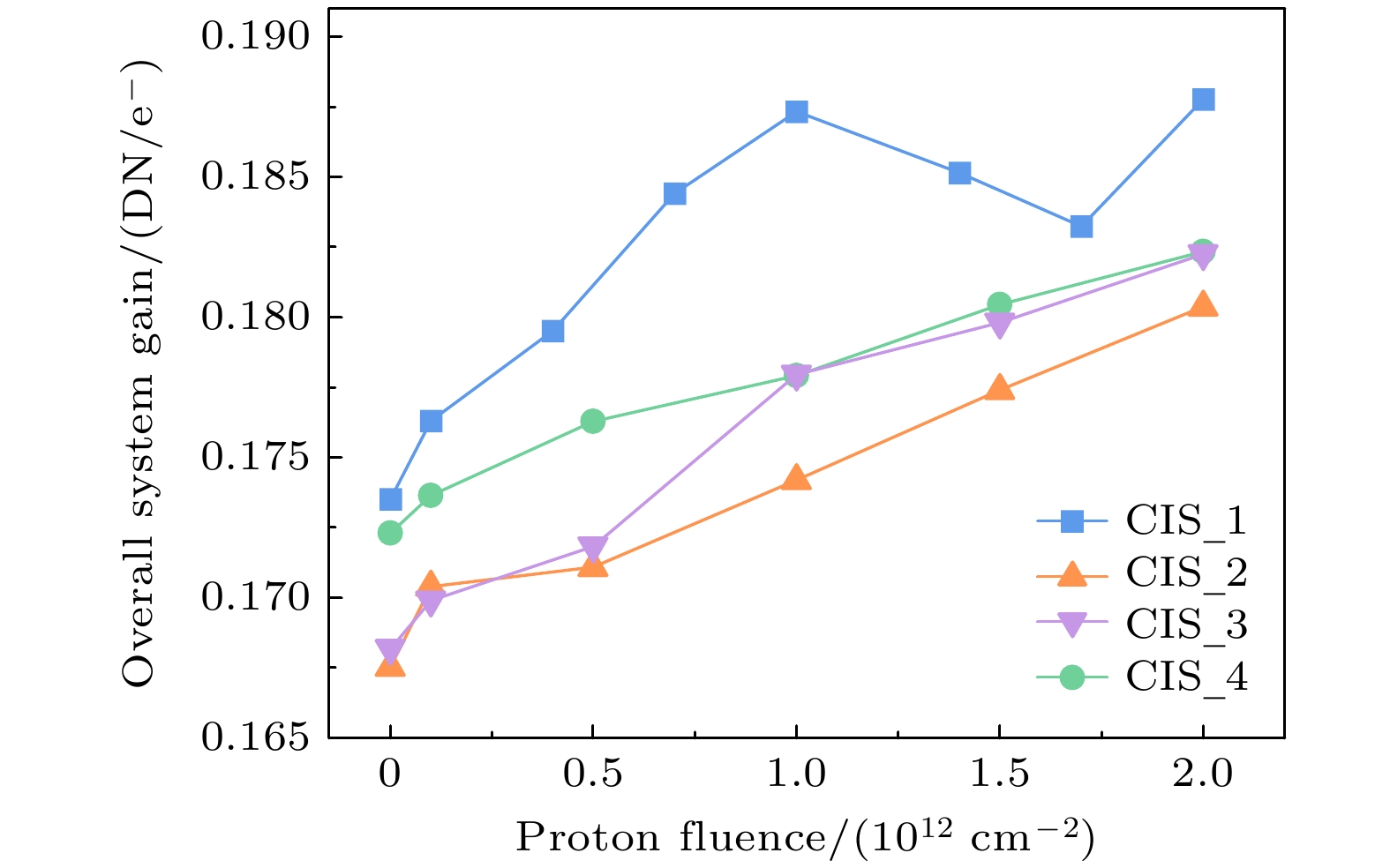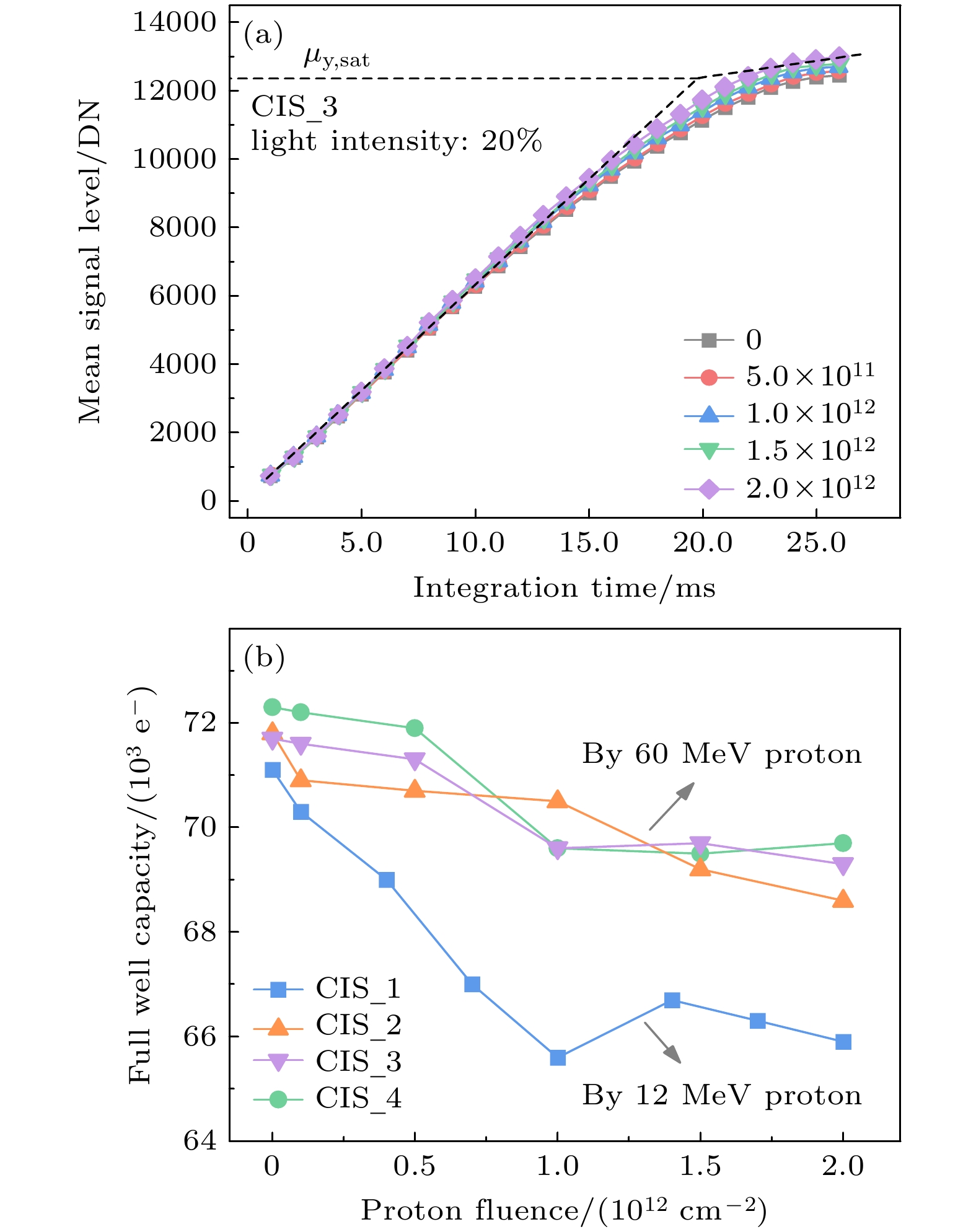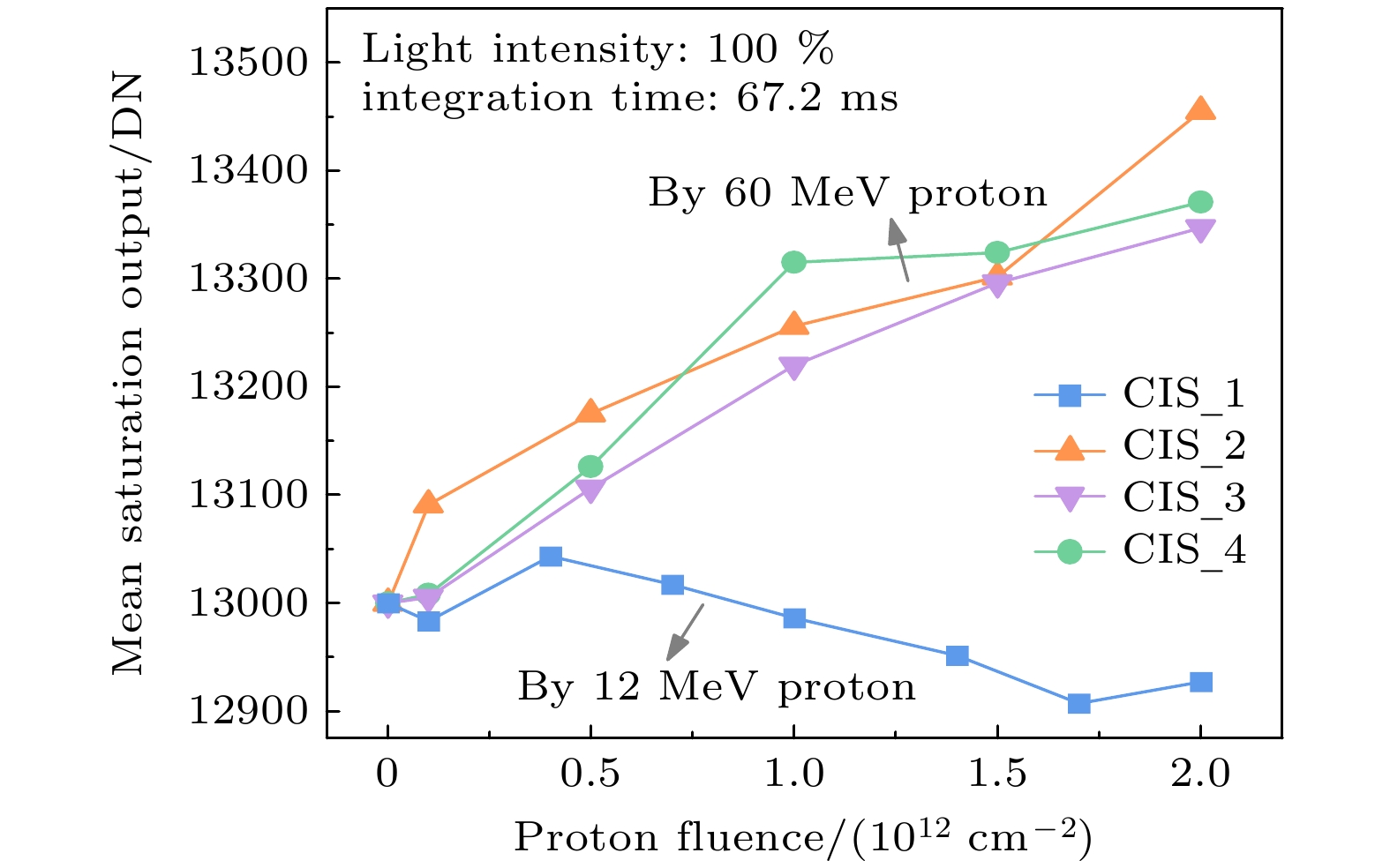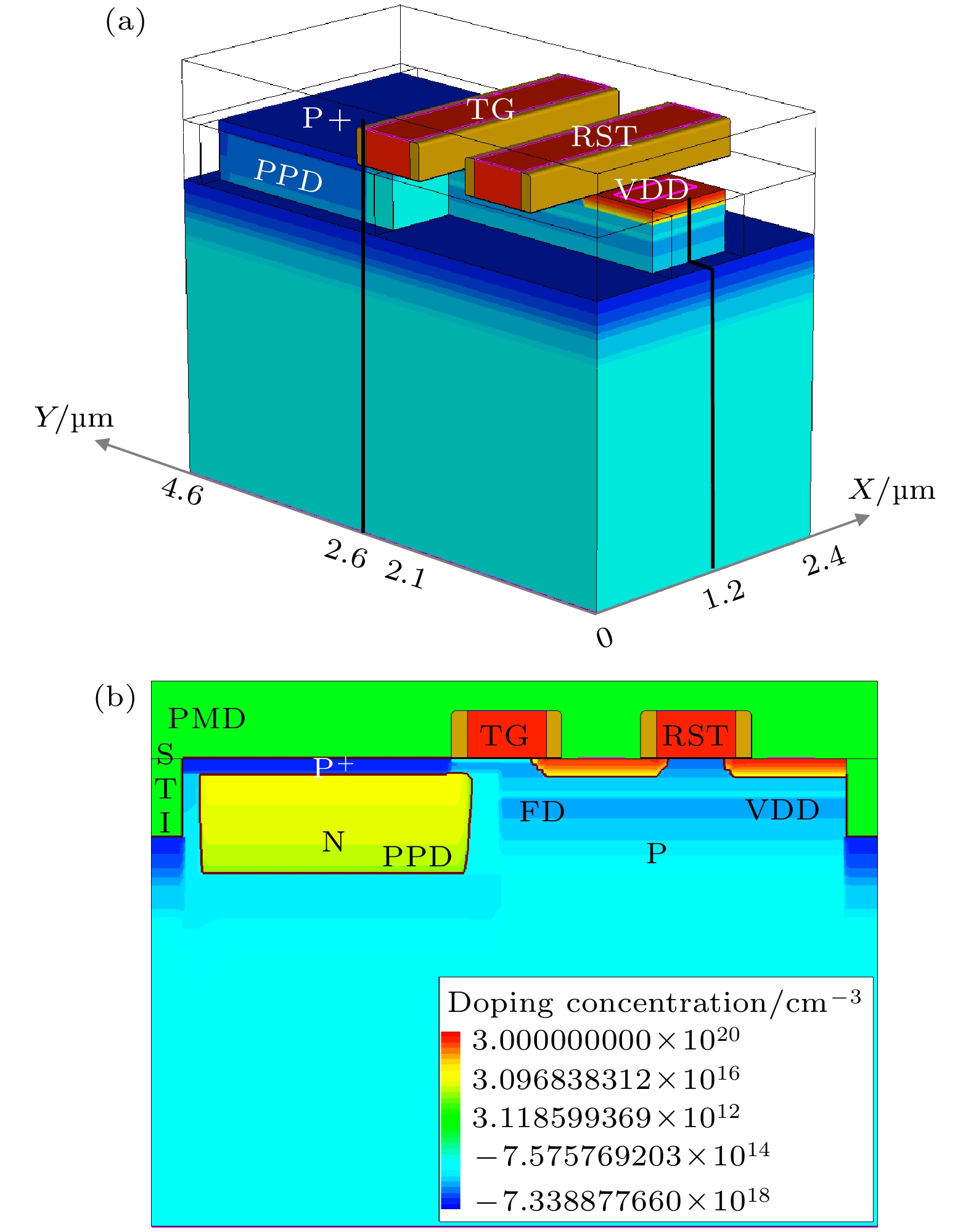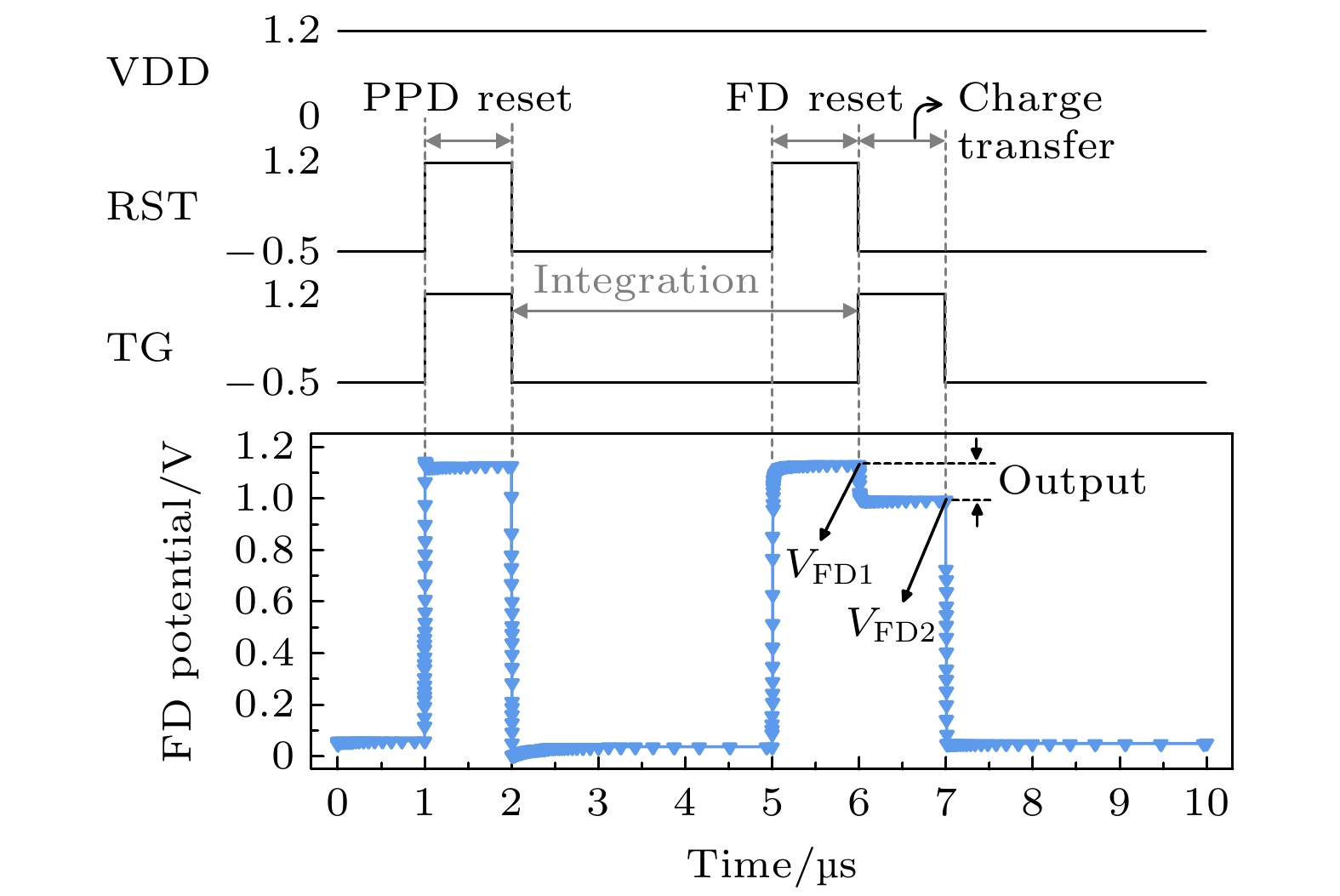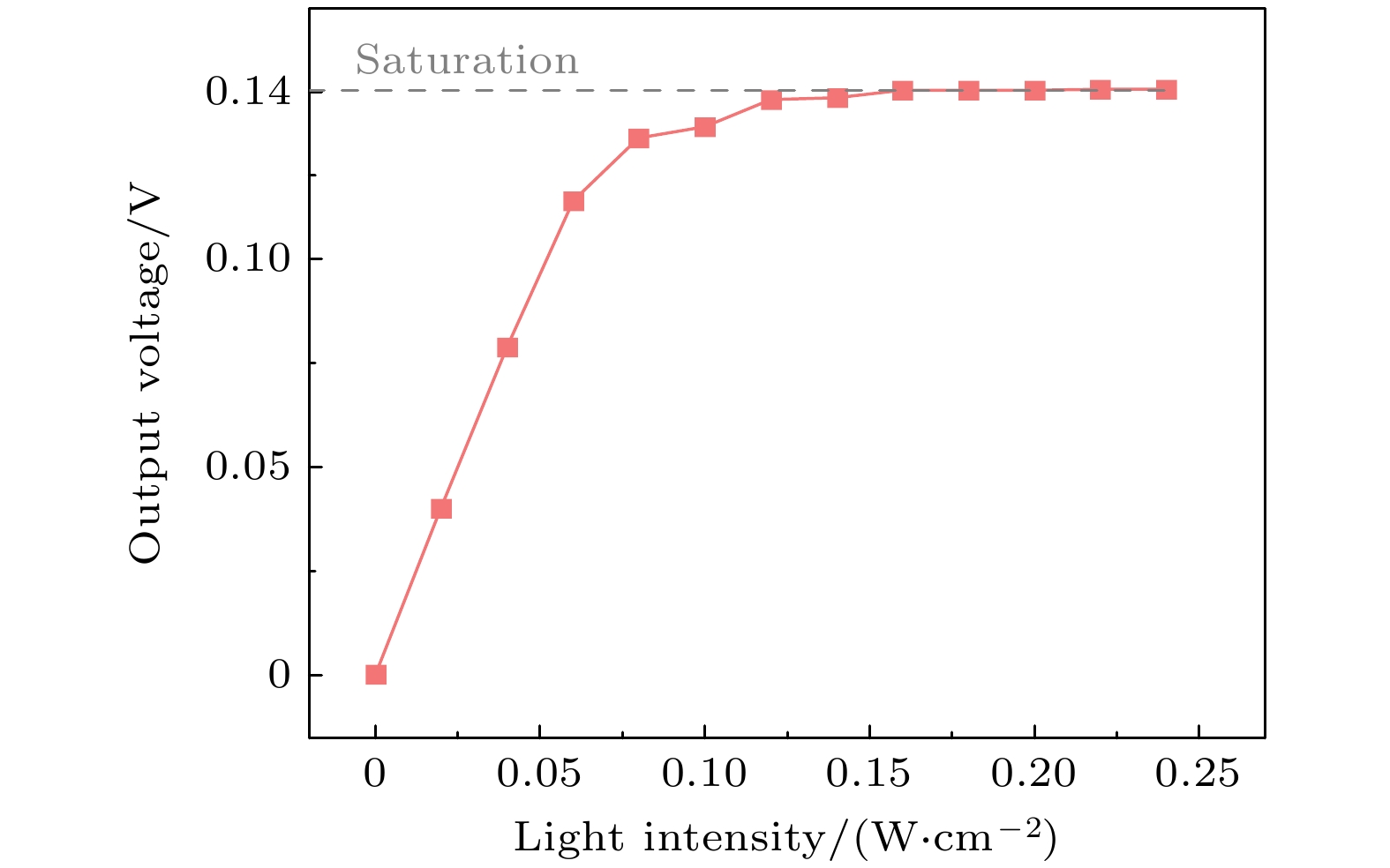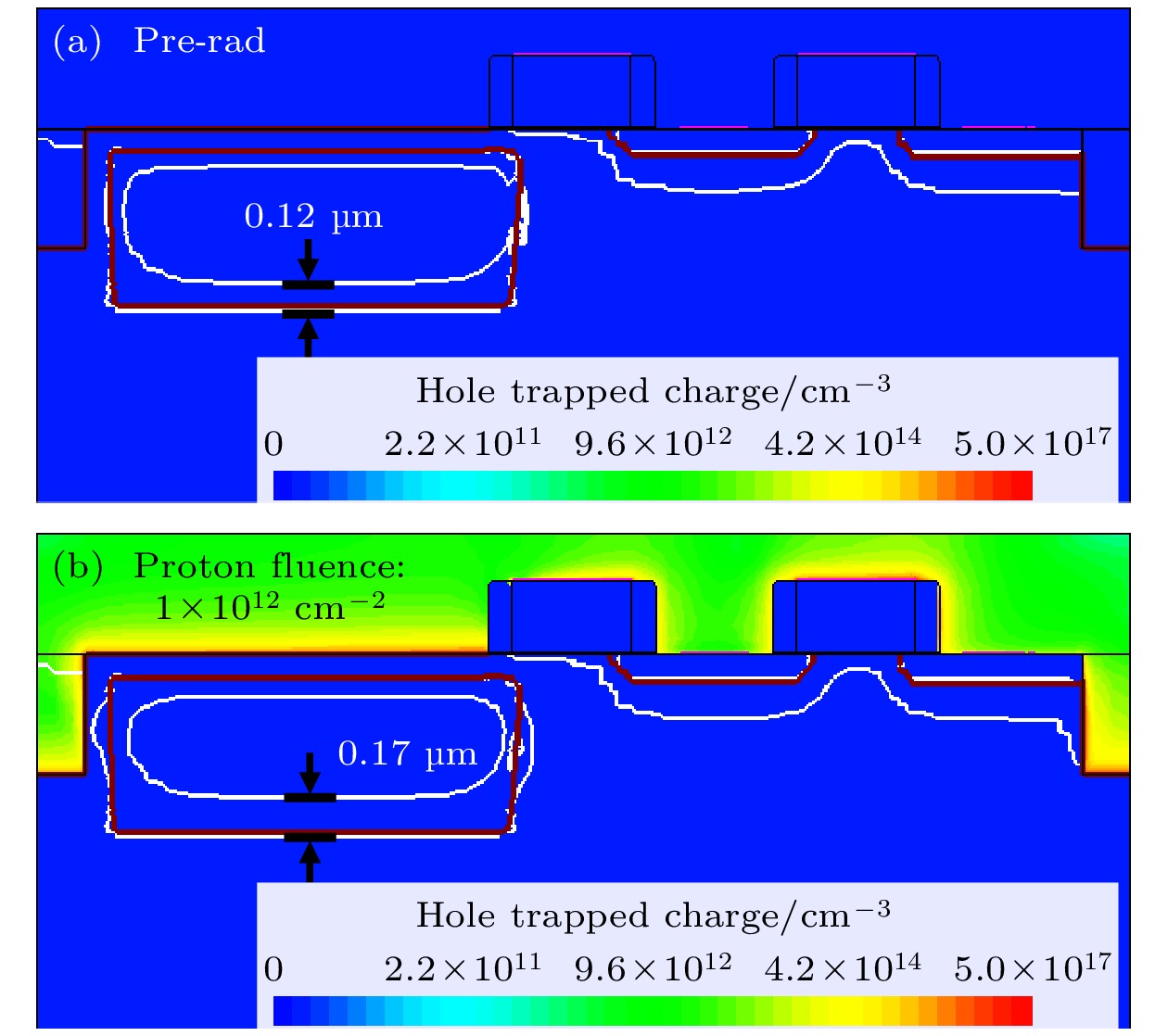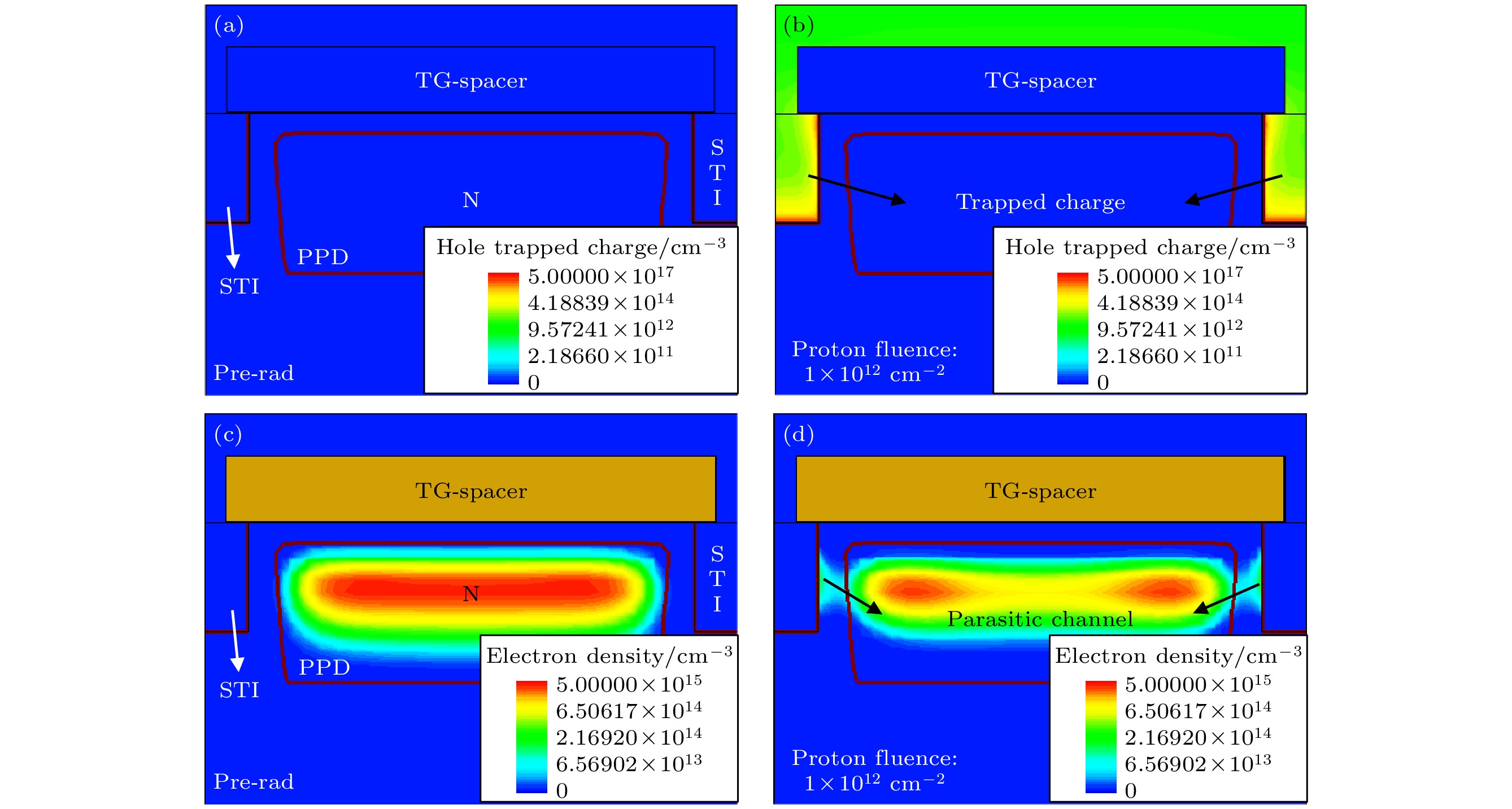-
Complementary metal oxide semiconductor (CMOS) image sensors have been increasingly widely used in the field of radiation environments due to their numerous advantages, and their radiation effects have also attracted much attention. Some experimental studies have shown that the saturation output of CMOS image sensors decreases after irradiation, while others have reported that it increases. In this work, the further in-depth research on the inconsistent results is conducted based on the proton irradiation experiments and TCAD simulations, and the degradation mechanism in full well capacity, conversion factor, and saturation output of the 4T pinned photodiode (PPD) CMOS image sensors due to proton cumulative radiation effects are also analyzed. In experiments, the sensors are irradiated by 12 MeV and 60 MeV protons with a fluence up to 2× 1012 cm–2. The sensors are unbiased during irradiation. The experimental results show that proton irradiation at 12 MeV and 60 MeV result in an increase of 8.2% and 7.3% in conversion factor, respectively, and a decrease of 7.3% and 3.8% in full well capacity, respectively. The saturation output shows no significant change trend under 12 MeV proton irradiation, but increases by 3% under 60 MeV proton irradiation. In the TCAD simulation, a three-dimensional 4T PPD pixel model is constructed. A simulation method that combines the trap and gamma radiation model in TCAD with the mathematical model of minority carrier lifetime is used to simulate global and local cumulative proton irradiation in order to analyze the degradation mechanism. It is proposed that the degradation of saturation output at the pixel level is determined by the full well capacity of PPD, the physical characteristics of the reset transistor and the capacitance of floating diffusion, but they have opposite effects. Proton irradiation leads to the accumulation of oxide-trapped positive charges in the shallow trench isolation on both sides of PPD, resulting in the formation of leakage current path in silicon, thereby reducing the full well capacity. A decrease in full well capacity leads to a decrease in saturation output. While, the radiation effect of the reset transistor causes the potential of floating diffusion (FD) to increase during the FD reset phase, further leading to an increase in saturation output. The irradiation causes the capacitance of the floating diffusion to decrease, resulting in an increase in conversion factor and consequently increasing the saturation output. The difference in radiation sensitivity among the three influence factors at the pixel level may result in a decrease or increase in saturation output with proton fluence increasing. The above work comprehensively reveals and analyzes the mechanisms of degradation in full well capacity, conversion factor and saturation output after irradiation, and the research results have certain guiding significance for analyzing the radiation damage to CMOS image sensors.
-
Keywords:
- CMOS image sensor /
- total ionizing dose /
- saturation output /
- full well capacity /
- conversion factor
[1] 王祖军, 刘静, 薛院院, 何宝平, 姚志斌, 盛江坤 2017 半导体光电 38 1
Wang Z J, Liu J, Xue Y Y, He B P, Yao Z B, Sheng J K 2017 Semiconductor Optoelectronics 38 1
[2] Goiffon V, Estribeau M, Magnan P 2009 IEEE Trans. Electron Devices 56 2594
 Google Scholar
Google Scholar
[3] Virmontois C, Goiffon V, Magnan P, Girard S, Inguimbert C, Petit S, Rolland G, Saint-Pe O 2010 IEEE Trans. Nucl. Sci. 57 3101
[4] Le Roch A, Virmontois C, Paillet P, Belloir J M, Rizzolo S, Marcelot O, Dewitte H, Van Uffelen M, Casellas L M, Magnan P, Goiffon V 2020 IEEE Trans. Nucl. Sci. 67 1241
 Google Scholar
Google Scholar
[5] 汪波, 李豫东, 郭旗, 刘昌举, 文林, 玛丽娅, 孙静, 王海娇, 丛忠超, 马武英 2014 63 056102
 Google Scholar
Google Scholar
Wang B, Li Y D, Guo Q, Liu C J, Wen L, Ma L Y, Sun J, Wang H J, Cong Z C, Ma W Y 2014 Acta Phys. Sin. 63 056102
 Google Scholar
Google Scholar
[6] 王帆, 李豫东, 郭旗, 汪波, 张兴尧, 文林, 何承发 2016 65 024212
 Google Scholar
Google Scholar
Wang F, Li Y D, Guo Q, Wang B, Zhang X Y, Wen L, He C F 2016 Acta Phys. Sin. 65 024212
 Google Scholar
Google Scholar
[7] Rizzolo S, Goiffon V, Estribeau M, Paillet P, Marcandella C, Durnez C, Magnan P 2018 IEEE Trans. Nucl. Sci. 65 84
 Google Scholar
Google Scholar
[8] 汪波, 李豫东, 郭旗, 文林, 孙静, 王帆, 张兴尧, 玛丽娅 2015 强激光与粒子束 27 210
 Google Scholar
Google Scholar
Wang B, Li Y D, Guo Q, Wen L, Sun J, Wang F, Zhang X Y, Ma L Y 2015 High Power Laser Part. Beams 27 210
 Google Scholar
Google Scholar
[9] 汪波, 李豫东, 郭旗, 刘昌举, 文林, 任迪远, 曾骏哲, 玛丽娅 2015 64 084209
 Google Scholar
Google Scholar
Wang B, Li Y D, Guo Q, Liu C J, Wen L, Ren D Y, Zeng J Z, Ma L Y 2015 Acta Phys. Sin. 64 084209
 Google Scholar
Google Scholar
[10] Fu J, Feng J, Li Y D, Guo Q, Wen L, Zhou D, Zhang X, Cai Y L, Liu B K 2021 Radiat. Phys. Chem. 182 109384
 Google Scholar
Google Scholar
[11] Wang Z J, Xue Y Y, Guo X Q, Bian J Y, Yao Z B, He B P, Ma W Y, Sheng J K, Dong G T, Liu Y 2018 Nucl. Instrum. Methods A 895 35
 Google Scholar
Google Scholar
[12] Goiffon V, Estribeau M, Marcelot O, Cervantes P, Magnan P, Gaillardin M, Virmontois C, Martin-Gonthier P, Molina R, Corbiere F, Girard S, Paillet P, Marcandella C 2012 IEEE Trans. Nucl. Sci. 59 2878
 Google Scholar
Google Scholar
[13] Wang Z J, Ma W Y, Huang S Y, Yao Z B, Liu M B, He B P, Liu J, Sheng J K, Xue Y 2016 AIP Adv. 6 035205
 Google Scholar
Google Scholar
[14] Meng X, Stefanov K D, Holland A D 2020 IEEE Trans. Nucl. Sci. 67 1107
 Google Scholar
Google Scholar
[15] Virmontois C, Durnez C, Estribeau M, Cervantes P, Avon B, Goiffon V, Magnan P, Materne A, Bardoux A 2017 IEEE Trans. Nucl. Sci. 64 38
 Google Scholar
Google Scholar
[16] Lai S K, Wang Z J, Huang G, Xue Y Y, Nie X, Tang N, Yan S X, Wang X H 2023 Nucl. Instrum. Methods A 1050 168069
 Google Scholar
Google Scholar
[17] 杨勰, 霍勇刚, 王祖军, 尚爱国, 薛院院, 贾同轩 2022 光学学报 42 0723002
 Google Scholar
Google Scholar
Yang X, Huo Y G, Wang Z J, Shang A G, Xue Y Y, Jia T X 2022 Acta Opt. Sin. 42 0723002
 Google Scholar
Google Scholar
[18] Peng Z G, Fu Y J, Wei Y, Zuo Y H, Niu S L, Zhu J H, Guo Y X, Liu F, Li P, He C H, Li Y H 2024 AIP Advances 14 015211
 Google Scholar
Google Scholar
[19] Wang Z M, Chen W, Qiu M T, Yan Y H, Zhang H, Wang M W, Wang B C, Yang Y, Wang D, Liu W L, Wang M C, Lv W, Zhao M T, Zhao C, Wei C Y, Yao H J, Zheng S X, Wang X W, Guan X L, Xing Q Z, Cheng C, Du T B, Zhang H Y, Lei Y, Wang D, Du C T, Ma P F, Liu X Y, Li Y, Ye W B, Yu X D 2022 Nucl. Instrum. Methods A 1027 166283
 Google Scholar
Google Scholar
[20] Khan U, Sarkar M 2018 IEEE Trans. Electron Devices 65 2892
 Google Scholar
Google Scholar
[21] Wang Z J, Xue Y Y, Wang Z M, Chen W, Yin L Y, Wang X H, Nie X, Lai S K, Huang G, Wang M C, Ding L L, He B P, Ma W Y, Gou S L 2024 Nucl. Instrum. Methods A 1058 168784
 Google Scholar
Google Scholar
[22] Petrosyants K O, Kozhukhov M V 2016 IEEE Trans. Nucl. Sci. 63 2016
 Google Scholar
Google Scholar
[23] Poivey C, Hopkinson G 2009 ESA—EPFL Space Center Workshop June, 2009 p9
[24] Wang C H, Bai X Y, Chen W, Yang S C, Liu Y, Jin X M, Ding L L 2015 Nucl. Instrum. Methods A 796 108
 Google Scholar
Google Scholar
[25] Gregory B L, Gwyn C W 1970 IEEE Trans. Nucl. Sci. 17 325
 Google Scholar
Google Scholar
[26] Marshall C J , Marshall P W 1999 Nuclear and Space Radiation Effects Conference, Short Course Norfolk, Virginia, July 12–16, 1999 p50
[27] Lee M S, Lee H C 2013 IEEE Trans. Nucl. Sci. 60 3084
 Google Scholar
Google Scholar
[28] Johnston A H, Swimm R T, Allen G R, Miyahira T F 2009 IEEE Trans. Nucl. Sci. 56 1941
 Google Scholar
Google Scholar
[29] Hu Z Y, Liu Z L, Shao H, Zhang Z X, Ning B X, Chen M, Bi D W, Zou S C 2011 IEEE Trans. Nucl. Sci. 58 1332
 Google Scholar
Google Scholar
-
图 10 辐照前后PPD两侧氧化物陷阱正电荷和电子浓度分布 (a) 辐照前陷阱正电荷; (b) 辐照后陷阱正电荷; (c) 辐照前电子浓度; (d) 辐照后电子浓度
Figure 10. Distribution of oxide-trapped positive charges in STI on both sides of the PPD during FD reset stage: (a) Positive charges before irradiation; (b) positive charges after irradiation; (c) electron concentration distribution before irradiation; (d) electron concentration distribution after irradiation.
表 1 辐照参数
Table 1. Irradiation parameters.
CIS编号 质子能量/MeV 最大质子注量/cm–2 DDD/(TeV·g–1) TID/krad(Si) CIS_1 12 2.0×1012 17638 962 CIS_2, 3, 4 60 2.0×1012 8286 275 表 2 12 MeV和60 MeV质子等效计算结果
Table 2. Equivalent results for 12 MeV and 60 MeV protons.
质子能量
/MeV质子注量
/(1011cm–2)等效中子注量
/(1011 cm–2)等效TID
/krad(Si)12 1.0 3.0 48.1 4.0 12.0 192.3 7.0 21.0 336.6 10.0 30.0 480.8 60 1.0 1.0 13.7 4.0 4.0 55.1 7.0 7.0 96.4 10.0 10.0 137.4 -
[1] 王祖军, 刘静, 薛院院, 何宝平, 姚志斌, 盛江坤 2017 半导体光电 38 1
Wang Z J, Liu J, Xue Y Y, He B P, Yao Z B, Sheng J K 2017 Semiconductor Optoelectronics 38 1
[2] Goiffon V, Estribeau M, Magnan P 2009 IEEE Trans. Electron Devices 56 2594
 Google Scholar
Google Scholar
[3] Virmontois C, Goiffon V, Magnan P, Girard S, Inguimbert C, Petit S, Rolland G, Saint-Pe O 2010 IEEE Trans. Nucl. Sci. 57 3101
[4] Le Roch A, Virmontois C, Paillet P, Belloir J M, Rizzolo S, Marcelot O, Dewitte H, Van Uffelen M, Casellas L M, Magnan P, Goiffon V 2020 IEEE Trans. Nucl. Sci. 67 1241
 Google Scholar
Google Scholar
[5] 汪波, 李豫东, 郭旗, 刘昌举, 文林, 玛丽娅, 孙静, 王海娇, 丛忠超, 马武英 2014 63 056102
 Google Scholar
Google Scholar
Wang B, Li Y D, Guo Q, Liu C J, Wen L, Ma L Y, Sun J, Wang H J, Cong Z C, Ma W Y 2014 Acta Phys. Sin. 63 056102
 Google Scholar
Google Scholar
[6] 王帆, 李豫东, 郭旗, 汪波, 张兴尧, 文林, 何承发 2016 65 024212
 Google Scholar
Google Scholar
Wang F, Li Y D, Guo Q, Wang B, Zhang X Y, Wen L, He C F 2016 Acta Phys. Sin. 65 024212
 Google Scholar
Google Scholar
[7] Rizzolo S, Goiffon V, Estribeau M, Paillet P, Marcandella C, Durnez C, Magnan P 2018 IEEE Trans. Nucl. Sci. 65 84
 Google Scholar
Google Scholar
[8] 汪波, 李豫东, 郭旗, 文林, 孙静, 王帆, 张兴尧, 玛丽娅 2015 强激光与粒子束 27 210
 Google Scholar
Google Scholar
Wang B, Li Y D, Guo Q, Wen L, Sun J, Wang F, Zhang X Y, Ma L Y 2015 High Power Laser Part. Beams 27 210
 Google Scholar
Google Scholar
[9] 汪波, 李豫东, 郭旗, 刘昌举, 文林, 任迪远, 曾骏哲, 玛丽娅 2015 64 084209
 Google Scholar
Google Scholar
Wang B, Li Y D, Guo Q, Liu C J, Wen L, Ren D Y, Zeng J Z, Ma L Y 2015 Acta Phys. Sin. 64 084209
 Google Scholar
Google Scholar
[10] Fu J, Feng J, Li Y D, Guo Q, Wen L, Zhou D, Zhang X, Cai Y L, Liu B K 2021 Radiat. Phys. Chem. 182 109384
 Google Scholar
Google Scholar
[11] Wang Z J, Xue Y Y, Guo X Q, Bian J Y, Yao Z B, He B P, Ma W Y, Sheng J K, Dong G T, Liu Y 2018 Nucl. Instrum. Methods A 895 35
 Google Scholar
Google Scholar
[12] Goiffon V, Estribeau M, Marcelot O, Cervantes P, Magnan P, Gaillardin M, Virmontois C, Martin-Gonthier P, Molina R, Corbiere F, Girard S, Paillet P, Marcandella C 2012 IEEE Trans. Nucl. Sci. 59 2878
 Google Scholar
Google Scholar
[13] Wang Z J, Ma W Y, Huang S Y, Yao Z B, Liu M B, He B P, Liu J, Sheng J K, Xue Y 2016 AIP Adv. 6 035205
 Google Scholar
Google Scholar
[14] Meng X, Stefanov K D, Holland A D 2020 IEEE Trans. Nucl. Sci. 67 1107
 Google Scholar
Google Scholar
[15] Virmontois C, Durnez C, Estribeau M, Cervantes P, Avon B, Goiffon V, Magnan P, Materne A, Bardoux A 2017 IEEE Trans. Nucl. Sci. 64 38
 Google Scholar
Google Scholar
[16] Lai S K, Wang Z J, Huang G, Xue Y Y, Nie X, Tang N, Yan S X, Wang X H 2023 Nucl. Instrum. Methods A 1050 168069
 Google Scholar
Google Scholar
[17] 杨勰, 霍勇刚, 王祖军, 尚爱国, 薛院院, 贾同轩 2022 光学学报 42 0723002
 Google Scholar
Google Scholar
Yang X, Huo Y G, Wang Z J, Shang A G, Xue Y Y, Jia T X 2022 Acta Opt. Sin. 42 0723002
 Google Scholar
Google Scholar
[18] Peng Z G, Fu Y J, Wei Y, Zuo Y H, Niu S L, Zhu J H, Guo Y X, Liu F, Li P, He C H, Li Y H 2024 AIP Advances 14 015211
 Google Scholar
Google Scholar
[19] Wang Z M, Chen W, Qiu M T, Yan Y H, Zhang H, Wang M W, Wang B C, Yang Y, Wang D, Liu W L, Wang M C, Lv W, Zhao M T, Zhao C, Wei C Y, Yao H J, Zheng S X, Wang X W, Guan X L, Xing Q Z, Cheng C, Du T B, Zhang H Y, Lei Y, Wang D, Du C T, Ma P F, Liu X Y, Li Y, Ye W B, Yu X D 2022 Nucl. Instrum. Methods A 1027 166283
 Google Scholar
Google Scholar
[20] Khan U, Sarkar M 2018 IEEE Trans. Electron Devices 65 2892
 Google Scholar
Google Scholar
[21] Wang Z J, Xue Y Y, Wang Z M, Chen W, Yin L Y, Wang X H, Nie X, Lai S K, Huang G, Wang M C, Ding L L, He B P, Ma W Y, Gou S L 2024 Nucl. Instrum. Methods A 1058 168784
 Google Scholar
Google Scholar
[22] Petrosyants K O, Kozhukhov M V 2016 IEEE Trans. Nucl. Sci. 63 2016
 Google Scholar
Google Scholar
[23] Poivey C, Hopkinson G 2009 ESA—EPFL Space Center Workshop June, 2009 p9
[24] Wang C H, Bai X Y, Chen W, Yang S C, Liu Y, Jin X M, Ding L L 2015 Nucl. Instrum. Methods A 796 108
 Google Scholar
Google Scholar
[25] Gregory B L, Gwyn C W 1970 IEEE Trans. Nucl. Sci. 17 325
 Google Scholar
Google Scholar
[26] Marshall C J , Marshall P W 1999 Nuclear and Space Radiation Effects Conference, Short Course Norfolk, Virginia, July 12–16, 1999 p50
[27] Lee M S, Lee H C 2013 IEEE Trans. Nucl. Sci. 60 3084
 Google Scholar
Google Scholar
[28] Johnston A H, Swimm R T, Allen G R, Miyahira T F 2009 IEEE Trans. Nucl. Sci. 56 1941
 Google Scholar
Google Scholar
[29] Hu Z Y, Liu Z L, Shao H, Zhang Z X, Ning B X, Chen M, Bi D W, Zou S C 2011 IEEE Trans. Nucl. Sci. 58 1332
 Google Scholar
Google Scholar
Catalog
Metrics
- Abstract views: 735
- PDF Downloads: 31
- Cited By: 0














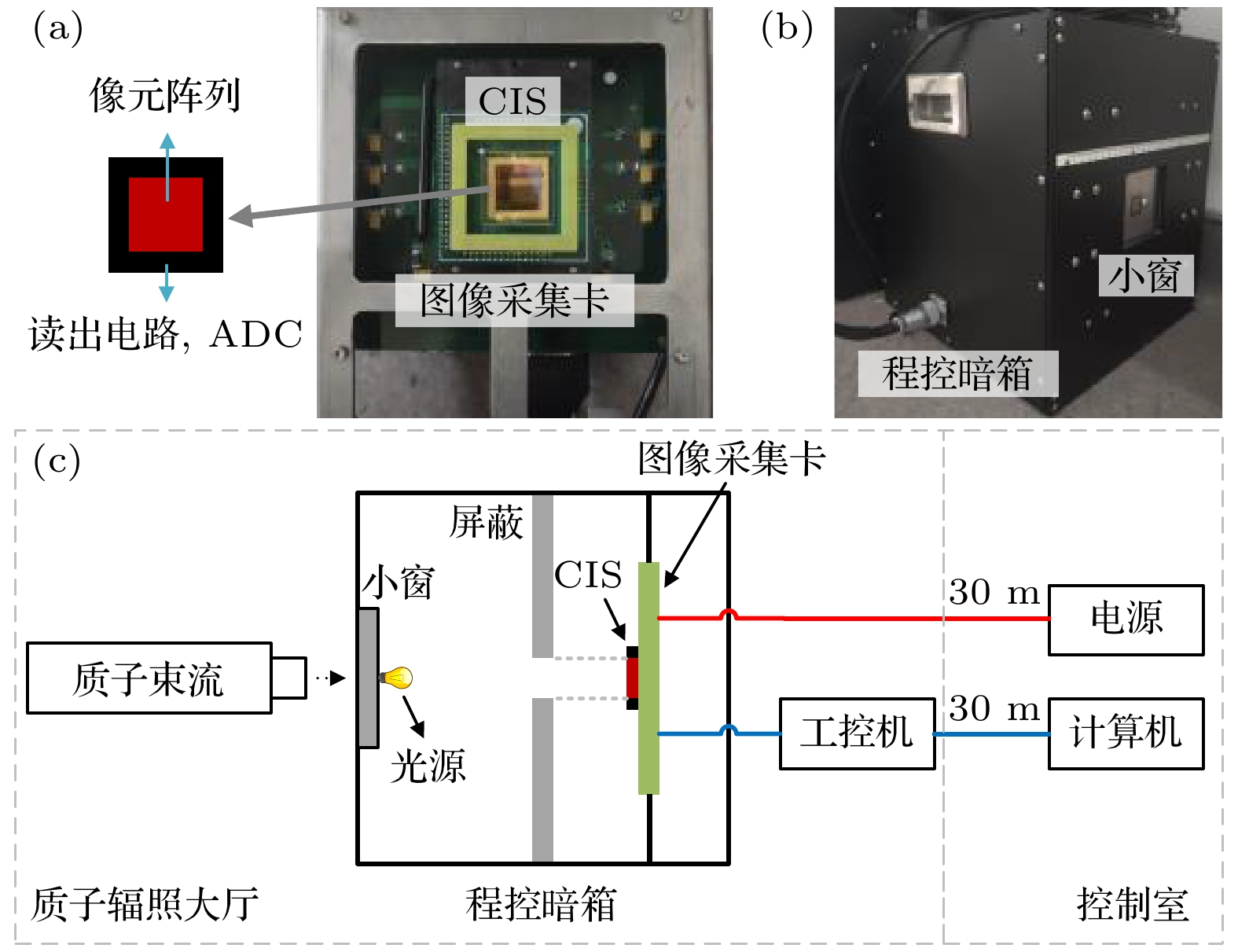
 DownLoad:
DownLoad:
